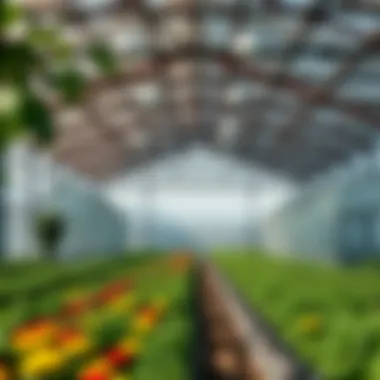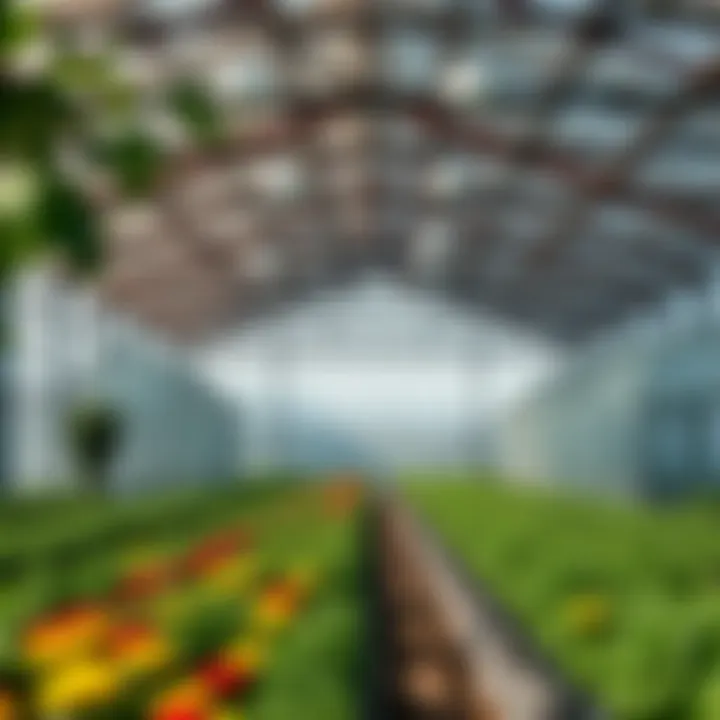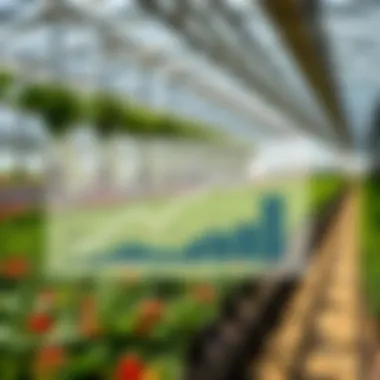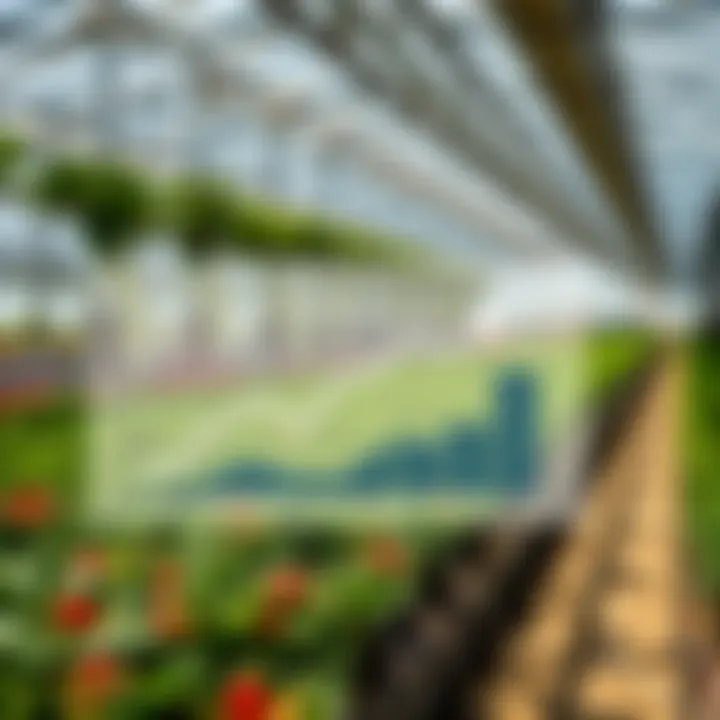Benefits and Considerations for Large Greenhouse Buyers


Intro
As more individuals and communities delve into the realm of sustainable agriculture, the pursuit of efficient gardening practices has never been more pronounced. One of the prime solutions that gardeners and farmers are gravitating toward is the large greenhouse. With its ability to create controlled environments for a wide variety of plants, it offers a nurturing setting that can amplify productivity.
Think of a greenhouse as a cradle for your plants; it shields them from unpredictable weather and pests while providing a haven with optimal growing conditions. This article lights the path toward understanding the multifaceted benefits and considerations associated with purchasing a large greenhouse, ensuring that you, the reader, can navigate through the options available to them.
Key Insights
Overview of the Topic
The concept of greenhouses isn't new. They've been used for centuries, but the demand for larger models has grown, especially among those serious about maximizing yield and sustainability. Large greenhouses not only allow for extended growing seasons but also enable the cultivation of plants that typically would not thrive under local conditions.
Importance in Agriculture/Horticulture/Agronomy
In the context of modern agriculture, large greenhouses serve a pivotal role. They support intensive vegetable production and ornamental plant cultivation, leading to higher efficiency and lower resource waste. By creating an environment that mimics optimal growing conditions, these structures can help stabilize food production, especially as climate changes disrupt traditional farming methods. All those gardening enthusiasts out there don't need someone to wave a magic wand; they can instead rely on science and good practices.
"The greenhouse effect can be harnessed to create micro-climates that precisely meet the needs of different plant species, thus elevating horticultural practices to a whole new level."
Sustainable Practices
Eco-Friendly Techniques
One of the most significant perks of having a large greenhouse is the opportunity to implement sustainable practices. Techniques such as rainwater harvesting, composting, and using solar panels can drastically reduce the carbon footprint associated with growing crops. Further, the use of organic pest management can help maintain an eco-friendly garden environment while reducing the reliance on chemical pesticides.
Case Studies on Sustainability
Take, for example, the case of Greenhouse Project in Ohio, where they have repurposed an old potato warehouse into an organic horticultural center. By utilizing energy-efficient technologies, such as geothermal heating, they reduce overall energy consumption while enriching the community with access to local organic produce.
Tools & Resources
Essential Equipment and Technologies
Investing in a large greenhouse also brings about the necessity of understanding various tools and equipment that elevate the gardening experience. Some essentials include:
- Temperature and humidity control systems: To maintain the desired climate.
- Automatic irrigation systems: Such as drip irrigation to conserve water efficiently.
- LED grow lights: For optimizing growth during lower light conditions.
Recommended Books and Readings
- The Greenhouse Gardener's Manual by Roger Marshall
- Greenhouse Vegetable Production in the Midwest by the University of Illinois Extension
- Sustainable Greenhouse Vegetable Production on www.extension.org
As you ponder whether to make the leap into the enchanting world of large greenhouses, remember: it's more than just a structure; it's an investment in the future of your gardening, sustainability, and, ultimately, the environment. This deep dive aims to enrich your understanding, preparing you to make an informed decision that aligns with your ambitions in agriculture.
Preface to Large Greenhouses
When one thinks of large greenhouses, the mind may drift to images of sprawling glass edifices, where vibrant flora thrives, insulated from the vagaries of the outside elements. But there’s much more to these botanical sanctuaries than size and aesthetics. They embody a truly unique approach to modern agriculture that carries significant weight in both personal gardening and commercial farming. This article aims to peel back the layers of what owning a large greenhouse entails, diving into its manifold benefits, essential considerations, and the decisions that need weighing before making such a significant investment.
Defining a Large Greenhouse
A large greenhouse is often characterized not merely by its physical dimensions but by its functionality and ability to create an optimal growing environment. Typically, these structures extend beyond the boundaries of the average hobbyist's setup, usually exceeding several hundred square feet. While the size is notable, its core purpose revolves around providing a controlled climate for plant cultivation.
From regional variations to specific crops, the designs and materials can vary immensely, allowing for adaptability to different agricultural practices. It's not just about panels of glass or polycarbonate; it’s about crafting a microclimate where plants can flourish—regardless of external weather conditions. The greenhouse could be freestanding, providing complete flexibility in site choice, or it could be attached to a building, benefiting from shared resources and possibly reduced energy costs. Understanding the nuance in these definitions is vital for anyone contemplating a greenhouse investment, with functionality taking precedence over mere size.
Importance in Modern Agriculture
In today's climate-conscious society, large greenhouses play a pivotal role in pushing the boundaries of what is possible in agriculture. These facilities are not only important for enabling year-round cultivation but they also contribute substantially to sustainability initiatives. Here are several key reasons why large greenhouses hold their ground in modern agriculture:
- Resource Efficiency: By enabling controlled growth conditions, large greenhouses drastically reduce water usage and pesticide application compared to traditional farming. These efficiencies can significantly lessen the ecological footprint.
- Crop Diversity: With the capacity to regulate temperature and humidity, various crops can be grown irrespective of seasonal limits. For instance, exotic fruits and vegetables that would otherwise wither in hostile weather can thrive in these environments.
"Large greenhouses can serve as a buffer against climate extremes, safeguarding food production against erratic weather patterns."
- Urban Agriculture Movement: As cities expand, large greenhouses have found their place as a viable solution to city nutrition. They can transform underutilized urban spaces or rooftops into productive landscapes, thereby increasing local food supply and reducing carbon emissions from transport.
- Cutting-edge Innovations: Many greenhouse setups incorporate high-tech features like automated watering systems, LED grow lights, and climate control systems, which not only optimize growth but also represent the future of farming technology.
In sum, the importance of large greenhouses in modern agriculture cannot be overstated. They stand at the intersection of innovation and necessity, offering solutions that harmonize with sustainable practices and the evolving demands of global food production. As we continue to explore this topic, it will be essential to consider the various avenues available for potential greenhouse owners, a journey through which the benefits of investing in a large greenhouse will be further illuminated.
Types of Large Greenhouses
In the world of gardening and sustainable agriculture, the type of greenhouse you choose can profoundly affect your gardening success. Large greenhouses serve numerous purposes from seed starting to nurturing tropical plants. With various styles and structures available, it is imperative to select one that aligns with your gardening goals. Here’s a closer look at different types of large greenhouses that farmers and gardening enthusiasts encounter.


Freestanding vs. Attached Greenhouses
Freestanding greenhouses stand alone, often in a garden or backyard, allowing for maximum light exposure from all angles. These structures are beneficial for those who have ample space and desire a dedicated area for gardening without distractions. A freestanding model allows for full customization with features like ventilation, shading, and even rainwater collection systems to ease maintenance.
In contrast, attached greenhouses are connected to an existing building, typically leveraging the warmth from the adjacent structure. These are ideal for those who have limited space or want to save on operational costs. However, they might have limited light exposure depending on the location of the building they’re attached to. Homeowners often find that an attached greenhouse can seamlessly blend with their home aesthetic while providing a useful gardening extension.
Both types of greenhouses have their advantages. Selecting the right type depends on the available space, budget, and gardening objectives.
Gothic Arch vs. Flat Roof Structures
Greenhouses come in various shapes, with Gothic arch and flat roof structures being among the most popular. Gothic arch greenhouses are characterized by their peaked roofs, which promotes better water drainage and allows for taller plants. Such structures tend to perform well in areas with heavy snowfall or rain because the sloped roof prevents the buildup of moisture that could weaken the structure.
On the other hand, flat roof greenhouses, while easier to construct, may not handle heavy precipitation as efficiently. However, they can be advantageous in regions with less rainfall. An appealing feature of flat roof designs is the possibility of expanding the greenhouse by adding layers or structures on top for different purposes, a popular option for urban gardening enthusiasts who want to maximize their limited space.
Material Considerations
The materials used for constructing a greenhouse not only determine the initial appearance but also play significant roles in insulation, durability, and maintenance. Here, we take a look at three primary materials: glass, polycarbonate, and plastic.
Glass
Glass greenhouses have been cherished for many years due to their timeless aesthetic and superior light transmission. One crucial aspect is the way they allow natural sunlight to penetrate deep into the space, creating an ideal environment for photosynthesis. Whole-hearted gardeners often favor glass as it helps maintain an even temperature, which is vital for plant health.
However, a notable downside is that glass can be heavy, requiring a sturdy framework to support its weight. It can also be a bit more fragile; therefore, it’s essential to consider climate—especially if you live in areas with high winds or potential severe weather. This means maintaining a delicate balance between elegance and durability.
Polycarbonate
Polycarbonate is another material that has gained popularity over recent years. It comes in sheets that offer excellent strength while being relatively lightweight. The key characteristic of polycarbonate is its impact resistance, making it ideal for regions prone to hail or intense storms. This material provides excellent insulation compared to glass; it retains heat in cooler temperatures while minimizing heat loss during the night.
One unique feature of polycarbonate is its dual-wall construction, which increases its insulation capabilities. As much as polycarbonate has its advantages, it can scratch over time and may need replacement sooner than glass, which can become a practical consideration for long-term gardeners.
Plastic
Plastic greenhouses are typically constructed with polyethylene film or panels. They are well-known for their affordability. The benefit of plastic is clear—it’s light, flexible, and easy to install, which makes it a go-to option for many hobbyists and beginner gardeners. Plastic can also provide good insulation, helping to keep heat during colder months.
A unique feature of plastic is its capability to be easily warped or changed to accommodate various gardening styles, but it's crucial to keep in mind that plastic may not last as long as glass or polycarbonate. It can degrade under UV exposure, leading to additional replacement expenses down the line.
In examining these materials, it's essential to weigh their respective pros and cons concerning the specific gardening requirements and the local climate. Understanding the implications of each choice helps in making a sound decision that enhances the overall gardening experience.
Evaluating Your Gardening Needs
Evaluating your gardening needs is a pivotal step when considering a large greenhouse purchase. It is not merely about placing a structure in your backyard; it involves understanding how the greenhouse will fit into your gardening goals, available resources, and personal preferences. Careful assessment ensures that your investment yields maximum benefits while minimizing potential setbacks.
Assessing Available Space
When thinking about a large greenhouse, space is king. The location must accommodate not only the size of the greenhouse but also allow for necessary accessibility and expansion as needed. Here’s what to consider:
- Measure Your Area: Take the time to measure the designated space. Knowing the exact dimensions will prevent headaches later on when trying to fit a greenhouse that may be too large.
- Orientation Matters: Think about sunlight and wind direction. For instance, placing the greenhouse where it captures sunlight throughout the day is crucial for optimal plant growth. South-facing areas are often ideal, depending on local terrain and weather conditions.
- Access Ways: Make sure there’s ample room surrounding the greenhouse for easy access. This includes paths for maintenance, harvesting, and watering. Nobody wants to be crawling over bushes to get to their prized tomatoes!
- Utility Connections: If you plan on installing electricity or water features, assess if those resources are readily available. Running electric lines or water pipes can be an additional headache and some potential unexpected costs if not considered early.
"Taking the required measurements can ultimately save you a ton of time—and money. An ill-fitted greenhouse is just an expensive garden shed."
Understanding Climate Considerations
Climate plays a crucial role in greenhouse gardening. Your local weather conditions will influence not only the type of plants you can grow but also how you set up your greenhouse. Here are some aspects to consider:
- Temperature Variations: If you live in an area with wide temperature fluctuations, you may want to invest in heating systems or cooling fans. Heat retention options like double-glazing in glass structures can also significantly aid in maintaining stable temperatures.
- Humidity Levels: Some plants thrive in humid conditions while others wilt. Understanding your local humidity levels can assist in selecting a greenhouse with adequate ventilation options. Fans, vents, and even misting systems can keep humidity in check while ensuring healthy plant growth.
- Season Length: Consider the length of your growing season. If you’re in a region with prolonged winters, having features like thermal mass or insulation may allow for extended growing seasons. Conversely, in areas with short winters, simple ventilation can suffice.
- Wind Patterns: Finally, take note of prevailing winds. A greenhouse positioned to shield walls can protect fragile vegetation from harsh gusts and potential storm damage. Reinforcement solutions could be necessary depending on your region.
By meticulously evaluating your space and understanding climatic influences before buying a greenhouse, you ensure a sound investment that aligns with both your gardening ambitions and environmental realities.
Financial Considerations
When it comes to investing in a large greenhouse, financial considerations play a pivotal role. This isn't just about the initial outlay of cash; it’s a broader evaluation of how this investment will stack up over time. Navigating the financial landscape requires a clear understanding of both immediate costs and future implications. By carefully assessing these aspects, potential buyers can safeguard their investments and ensure that they are enhancing both productivity and sustainability in their gardening endeavors.
Initial Investment and Cost Analysis
The very first foal of the financial journey into greenhouse ownership is understanding the upfront costs. This initial investment can vary widely based on several factors, including size, materials, and included features. For instance, a mid-sized greenhouse constructed from polycarbonate may set you back around $7,000, while a larger glass structure could easily touch $20,000 or more. It’s worth noting that this base price often doesn’t include delivery and assembly.
- Materials Matter: Choosing between glass, polycarbonate, or plastic can significantly shift these numbers. Glass greenhouses, while offering superior aesthetics and durability, often demand higher initial costs. Polycarbonate, on the other hand, provides a good balance of price and performance.
- Accessories Cost: Don’t forget, initial costs also pile up with essential accessories like shading systems, heating units, or automated ventilation controls. Each of these systems enhances the greenhouse environment but comes at a price.
Evaluating your gardening objectives will help in understanding what features you truly need versus what may just be bells and whistles. A focused approach will ensure that you won’t end up with unnecessary expenses. Get the calculator out and prepare detailed estimates, leaving a little wiggle room for unexpected expenses.


Long-term Operational Costs
While the initial investment can hit hard, it's the long-term operational costs that will give you a clearer picture of your financial commitment. This includes everything from heating and cooling expenses to maintenance and water usage.
- Heating and Cooling Needs: In many regions, significant energy goes into maintaining optimal temperatures inside the greenhouse. Research has shown that heating costs can run anywhere from $300 to $1,500 per year, depending on the climate and size of the structure. On the flip side, during warmer months, cooling expenses might also bite into your budget.
- Maintenance Profile: Regular upkeep costs, such as replacing worn-out panels or repairing structural damage, should not be overlooked. A good guideline is to budget about 1-3% of the greenhouse's total value annually for these ongoing expenses.
- Water Supply: Depending on how you’ve set up your watering system, whether through drip irrigation or overhead sprinklers, water costs can also escalate. Understanding local water rates can help prepare for these recurring costs.
Ultimately, assessing your long-term operational expenses is just as crucial as the initial investment. Being proactive and setting up an efficient financial plan will not only help you budget better but also provide peace of mind as you dive into the world of greenhouse gardening.
"A penny saved is a penny earned; understanding your costs upfront can lead to a flourishing investment in the future."
For more detailed statistics on greenhouse operational costs, you might find resources on Wikipedia and Britannica insightful.
Buying Process Explained
Understanding the buying process of a large greenhouse is crucial, as it sets the stage for your entire gardening venture. This stage is where many potential buyers feel overwhelmed, juggling various factors from costs to quality. Recognizing the steps in this process can steer you towards an investment that not only meets your needs but also enhances your agricultural output.
When considering the purchase of a large greenhouse, it's paramount to have a solid plan and knowledge of the market. This preparation can help avoid pitfalls and ensure that your selection aligns with your gardening ambitions.
Researching Suppliers
When you're on the hunt for the perfect greenhouse, researching suppliers isn’t just a matter of skimming through a few websites. It’s about diving deep into the options available and understanding who’s who in the industry. You'll want to look for suppliers with a strong history of delivering quality greenhouses and reliable customer service. Reach out to gardening communities, whether it's on forums like Reddit or local agricultural clubs, to get recommendations and read reviews. Sometimes, word of mouth can enlighten you in ways that glossy brochures just can’t.
Key factors to keep in mind:
- Experience: How long has the supplier been in business? Longevity can often indicate reliability.
- Product Range: Check if they offer a variety of styles and sizes to fit your needs. Too narrow of a selection could mean limited options down the line.
- Customer Service: Pay attention to how they handle inquiries. A responsive supplier often indicates better support when issues arise.
By honing in on trustworthy suppliers, you weed out options that could end up being more trouble than they’re worth, paving the way for a smoother purchasing experience.
Comparing Features and Pricing
After pinpointing some potential suppliers, it’s time to roll up your sleeves and dive into the nitty-gritty of greenhouse features and pricing. Pricing can be misleading; the sticker price doesn’t always paint the full picture. Look beyond just the cost: consider what you’re getting for your money.
- Construction Material: Different materials, like polycarbonate or glass, come with varying price tags and benefits. For instance, while glass may offer superior light transmission, polycarbonate can provide better insulation.
- Size and Customization: Larger greenhouses obviously cost more, but think about whether you might need to customize features later. Sometimes, going just a tad bigger now can save you from a headache down the road.
- Added Features: Does the greenhouse come equipped with automatic ventilation systems or built-in shade cloth? Features like these can be more efficient than retrofitting them later, allowing you to optimize your growing conditions.
Ultimately, this phase of comparing features against price tags can lead you to a greenhouse that not only fits your budget but also fulfills your gardening aspirations.
"In thoughtful comparison of suppliers and their offerings, you arm yourself against making a hasty purchase that could hinder your future gardening success."
By ensuring the features align with your goals, you're setting yourself on a path toward fruitful harvests and fulfilling your agricultural dreams.
Scrutinizing Quality and Warranty
When it comes to purchasing a large greenhouse, taking a step back to scrutinize the quality and warranty of the structure is immensely important. High costs often accompany large greenhouse investments. Therefore, ensuring that the chosen greenhouse meets the desired quality standards and includes a reliable warranty can save both heartache and money down the line. A sound structure that adheres to industry standards not only stands the test of time but also provides an optimal growing environment.
Quality can be assessed through a variety of factors: the materials utilized, the craftsmanship, and the overall durability of the greenhouse. A sturdy build is more likely to withstand harsh weather, minimizing risks such as damage from storms or heavy snowfall. Moreover, greenhouses built with high-quality materials will retain heat more effectively, which translates to lower energy costs and better plant growth.
Checking Industry Standards
In the greenhouse manufacturing world, industry standards serve as a crucial benchmark. These standards dictate everything from materials to construction techniques. As a would-be owner, checking whether a greenhouse complies with these standards should be on your to-do list. Certifications and compliance fall under this category, ensuring that the greenhouse not only meets safety requirements but also offers a sustainable approach to gardening.
Some essential points to consider include:
- Materials: Confirm whether the greenhouse uses materials like tempered glass or UV-resistant polycarbonate that meet safety standards.
- Design: Evaluate if the structure’s design adheres to wind load and snow load regulations to prevent potential collapses.
- Manufacturer Reputation: Investigate the manufacturer's track record. A brand with solid reviews is more likely to produce quality products.
Checking for compliance can save buyers a lot of headaches. As the old saying goes, "A stitch in time saves nine.” Ensuring that all materials and designs are up to snuff may prevent future repair costs or even costly losses of beloved plants.
"The right greenhouse can be a game-changer for your gardening journey, but quality must come first."
Understanding Warranty Terms
A well-thought-out warranty can be a beacon of security in any investment. Understanding the terms of the warranty can set you up for success or spell disaster if issues arise down the line. Warranty coverage often varies from one manufacturer to another, which makes it essential to read the fine print and ask clarifying questions before making a purchase.
When examining warranty terms, consider the following:
- Duration: Does the warranty last long enough to give you confidence in your investment? A longer warranty is indicative of the manufacturer’s commitment to their quality.
- Coverage Details: Check what is specifically covered. For example, does it include defects in materials, craftsmanship, and support structures? Knowing what’s included can be the difference between peace of mind and scrambling in a crisis.
- Exclusions: Many warranties include fine print about certain exclusions, such as damages resulting from improper installation or natural disasters. Understanding these can prevent future frustration.
- Service: Does the manufacturer provide support for warranty claims? Follow-up service can often be as valuable as the warranty itself.
In essence, scrutinizing the quality and warranty of a large greenhouse is not just about making an informed purchase. It’s about safeguarding your investment and, by extension, the health of your budding plants.


Setting Up Your Greenhouse
Setting up a greenhouse is no small task; it's akin to laying the groundwork for an extensive project that seeks to blend nature and nurturance. It’s where the magic of gardening takes place, and for anyone who's serious about sustainable agriculture, understanding how to properly set up a greenhouse can mean the difference between flourishing plants and dwindling hopes. It encompasses not just the physical structure, but crucial elements like site preparation and climate control systems, which are indispensable for creating an optimal growing environment.
Site Preparation and Foundation Needs
Before the first shovel of dirt is turned, you must consider the site where your greenhouse will stand. Choosing the right location can significantly impact your plants' growth. Ideally, the site should get ample sunlight—about six hours each day—while also considering potential wind barriers and water drainage.
Once you've settled on a site, the next step is preparing the ground. Leveling the area is essential. If you think about building a house, it’s much like ensuring the foundation is robust. You wouldn’t want your greenhouse to tilt or settle unevenly, right? Here are some key points to keep in mind:
- Clearing the Area: Remove any vegetation, including rocks and branches that might impede growth.
- Soil Testing: Conduct a soil test to check for pH levels and nutrient content. This step can guide future amendments you may need.
- Foundation Types:
- A concrete slab is often preferred as it provides a sturdy base and controls weeds.
- Wooden beams can also be used, but be cautious of moisture that can expedite decay.
By adequately preparing the site and choosing the right foundation, you set a solid precedent for a successful greenhouse venture.
Installing Climate Control Systems
Once the structure is up and the foundation set, it’s time to focus on climate control systems, which are the beating heart of a greenhouse. These systems ensure that your plants thrive, regardless of external weather conditions. Hence, environmental control can vary from simple to sophisticated setups.
Some critical elements to include:
- Ventilation: Good airflow is essential to prevent heat buildup and humidity. Consider installing automatic roof vents that open and close based on temperature thresholds.
- Heating: If you're in a cooler climate, you might need heating systems. Electric heaters or gas heaters can maintain ideal temperatures during winter months.
- Cooling Systems: In warmer climates, swamp coolers or exhaust fans can help reduce high temperatures.
- Humidity Control: Humidity can be regulated using misting systems or dehumidifiers to create an ideal microclimate for your crops.
Investing in these systems not only promotes healthy plant growth but can also alleviate potential stress on you as the gardener. It’s far more comforting knowing you’ve got the right conditions in place.
"Setting up your greenhouse isn’t merely about assembling a structure; it’s about crafting an ecosystem that allows your plants to thrive."
By acknowledging the importance of site preparation and climate controls, you can embark on a greenhouse journey that’s not only productive but also deeply fulfilling. This well-planned setup can propel your gardening ambitions to heights you might not have thought possible.
Maintaining Your Greenhouse
The joy of gardening can often lead to delving into the world of greenhouses, but it doesn’t end with just the purchase. Your large greenhouse represents a significant investment, both in terms of finances and time, making its maintenance crucial. Regular upkeep not only preserves the structures but also ensures optimal plant health and nutrient yield. Maintaining your greenhouse gives your plants the protection they need from extremes, diseases, and pests. An idea swirls around that a neglected greenhouse can quickly turn into a wasteland of wilting vegetation. Keeping a systematic maintenance routine helps you avoid that misstep.
Regular Upkeep Tasks
Engaging in regular upkeep is like feeding your greenhouse’s soul. Here are some critical tasks that keep the functionality of your space:
- Cleaning the Structure: Dust and debris on greenhouse panels can inhibit light—something plants thrive on. A biannual deep clean can do wonders. Grab a bucket, some mild soap, and a squeegee to keep the glass or polycarbonate surfaces crystal clear.
- Inspecting for Damage: Weather can be a fickle friend. Make it a habit to walk around your greenhouse at least once a month to look for cracks, leaks, or broken panes. Early detection can save you from more costly repairs later.
- Checking Ventilation Systems: Keeping air flowing in and out is essential for temperature control. Make sure fans are functioning and vents are clear of any obstructions. Stale air can lead to mold—nobody needs that in their lives.
- Monitoring Environment Conditions: Checking humidity and temperature with a reliable hygrometer and thermometer will give you the insights needed to create a perfect growing environment. Make adjustments with shade cloth or the heating system as needed.
- Watering Systems Maintenance: If you’re using a drip irrigation system, inspect it periodically. Clogged lines can lead to uneven watering. Replace filters and clean emitters, it can save you a headache later.
Overall, these tasks can be woven into a straightforward schedule. Dedicate a few hours in your calendar each month just like you would any other important event.
Troubleshooting Common Issues
Issues will inevitably arise; that’s the nature of gardening. But knowing how to troubleshoot them can set you apart from other greenhouse keepers. Here’s a brief list of common challenges and their fixes:
- Pest Invasion: Aphids and spider mites think a greenhouse is a buffet. Regularly check plant undersides and stems. Introduce beneficial insects like ladybugs, or, if needed, choose a targeted pesticide carefully. Always ensure that any chemicals are safe for your plants.
- Humidity Problems: Too high humidity can lead to mold, while too low can stress plants. If humidity is high, try increasing ventilation or using a dehumidifier during damp seasons. Get it right, and your plants will thank you.
- Temperature Fluctuations: If your plants show signs of stress, it could be temperature swings. Ensure your heating system kicks in during cold snaps and that shades deploy during blistering rays of sunshine. Use thermometer readings to adjust.
- Nutrient Deficiencies: Watch out for yellowing leaves or stunted growth, signs that your plants might be lacking. Conduct soil tests to determine what nutrients might be lacking and amend them accordingly, either with organic fertilizers or specialized nutrients.
By familiarizing yourself with maintenance practices and problem-solving strategies, you can steer clear of common pitfalls that can undermine the potential of your expansive green sanctuary. A well-maintained greenhouse can offer a fruitful bounty that makes all your efforts worthwhile.
Epilogue: Making an Informed Decision
Making a decision about purchasing a large greenhouse is not just a casual choice—it's a significant commitment that can affect your gardening productivity and even your finances for years to come. This conclusion doesn't aim to tie everything up neatly but to emphasize the crux of your journey through the sometimes complicated maze of greenhouse buying.
Reflecting on Benefits and Challenges
The advantages of investing in a large greenhouse are plentiful. Firstly, enhanced crop yield can be an immediate benefit, providing a controlled environment where plants can thrive. Your ability to extend the growing season is another major perk. Beyond that, the space allows you to experiment with various plant species that you might not be able to cultivate in open fields due to varying climate conditions.
However, it’s crucial to also weigh the challenges that come with this investment. The initial setup costs can give anyone a reason to pause. Not just the price of the greenhouse itself, but also the related expenses like site preparation and installation of climate control systems can add up faster than one might think.
"Every rose has its thorn, and with a greenhouse, the beauty must be balanced with the costs and maintenance involved."
Maintenance deserves special mention. Regular upkeep tasks, from cleaning the structure to managing pest control, can be labor-intensive. Each gardener must assess their own willingness and capacity to handle these challenges.
The decision takes into account both the shiny advantages and the gritty realities. When making this choice, it’s not just about how much you want to grow; it’s also about what you can realistically manage, both financially and operationally.
Future Trends in Greenhouse Gardening
As the world leans more into sustainability and eco-friendly practices, greener approaches to greenhouse gardening are on the rise. Techniques such as hydroponics and aquaponics are gaining popularity, offering options for growing without traditional soil. Coupled with advancements in technology, smart greenhouses are becoming a game changer. These are equipped with sensors that monitor everything from temperature to humidity, allowing you to focus your efforts where they matter most.
Likewise, there's a noticeable shift toward using more sustainable materials for greenhouse construction. For instance, recycled plastics and treatments that enhance energy efficiency are making waves, making greenhouses not just a place to grow but also a part of the solution to climate issues.
As more people embrace these new technologies and methods, it's prudent to consider how these shifts could influence your greenhouse setup. Keeping an open mind and adapting to these trends will not only enhance your gardening experience but also put you on the cutting edge of modern agricultural practices.
In wrapping up the article, recognize that the choice to invest in a large greenhouse is more than just a purchase. It’s an investment in your gardening future, which, when informed by both benefits and challenges, can lead to fruitful results.







